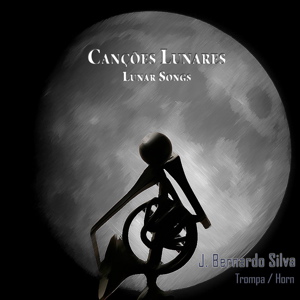[1] Otto KETTING (1935-): Intrada
[2] Richard STRAUSS (1864-1949): Introduction, Theme and Variations op.17
[3] Alexander SCRIABINE (1872-1915): Romance op. Posth.
[4] Hermann NEULING (1897-1966): Bagatelle
[5] Alexander GLAZUNOW (1865-1936)(arr.H.Baumann): Elegy, Op.17
[6]-[9] Charles KOECHLIN (1867-1950): Quatre Petites Pièces, for horn, violin and piano
[10]-[16]Eurico CARRAPATOSO (1962-): Sweet Rústica, horn and piano
[17] Gioacchino ROSSINI (1792-1868)(arr.H.Baumann): Le Rendez-vous de Chasse
[18] Jean-François LÉZÉ (1971): Dreams for horn and piano*
[19]-[22]Jean-François LÉZÉ (1971): Lunar Songs, for horn, tuba and piano*
[23] Jean-François LÉZÉ (1971): Tango & Paso Doble, for horn, tuba and piano*
J. BERNARDO SILVA – TROMPA / HORN
ELSA SILVA – PIANO / PIANO (except*)
SÉRGIO CAROLINO – TUBA / TUBA
EVANDRA GONÇALVES – VIOLINO / VIOLIN
JEAN-FRANÇOIS LÉZÉ – PIANO / PIANO*
Afinaudio Records IRFC.04.072, 2006
REVIEWS
- «The CD “Canções Lunares” [Lunar Songs] reveals the very charming, strong and warm sound of Portuguese horn player J. Bernardo Silva. His musicality is inspiring and as the title suggests it, Bernardo Silva creates a pleasant and calm atmosphere. Definitely an excellent recording!»
In Brass Bulletin
- « This is going be to a most welcome addition to your CD library for two reasons. First, it contains excellent performances. J. Bernardo Silva is an impressive soloist who can do it all. His technical skills and his expressive playing are first-rate. His high range and low range are both exceptional. He can sing, shout, whisper, laugh, and cry. His musical emotional extremes make every moment memorable.
Second, each work on this recording is a pleasurable listening experience. Repeated hearings have allowed me to appreciate the depth of expression in the music. I hear new, different, and wonderful features each time. Some of the works are familiar to most horn players and some are, to me at least, new.
I have heard Ketting’s Intada performed often on trumpet and I now have two recordings on horn – it is totally effective on horn as well as trumpet. Introduction, Theme and Variations by the very young Richard Strauss shows many signs of great horn writing to come. Scriabin’s Romance is concise and beautiful. Bagatelle by Hermann Neuling is a tour de force for the horn player who wants to show off low register virtuosity. Although originally intended for cello and piano, the Glazunov Elegie, as transcribed by Hermann Baumann, is a welcome addition to our literature.
The Charles Koechlin trio, Four Little Pieces, is a rather short, but beautiful expressive and melodic suite for violin, horn and piano – it deserves to be frequently performed. Carrapatoso’s Rustic Suite should become often-played staple of the horn recital literature. It is a descriptive and, almost, programmatic work that draws inspiration from the baroque dance suite – hearing Silva plays the Suite is a joy.
The three concluding works, all by Jean-François Lèzè, will leave you amazed. Sonhos is for horn and piano and Canções Lunares and Tango & Paso Doble are both for horn, tuba and piano. They are absolutely fantastic works, not easy, but beautiful and exciting, here played with flare, emotional depth, and complete virtuosity! »
Calvin Smith in “The Horn Call”
(Journal of the International Horn Society), May 2008
